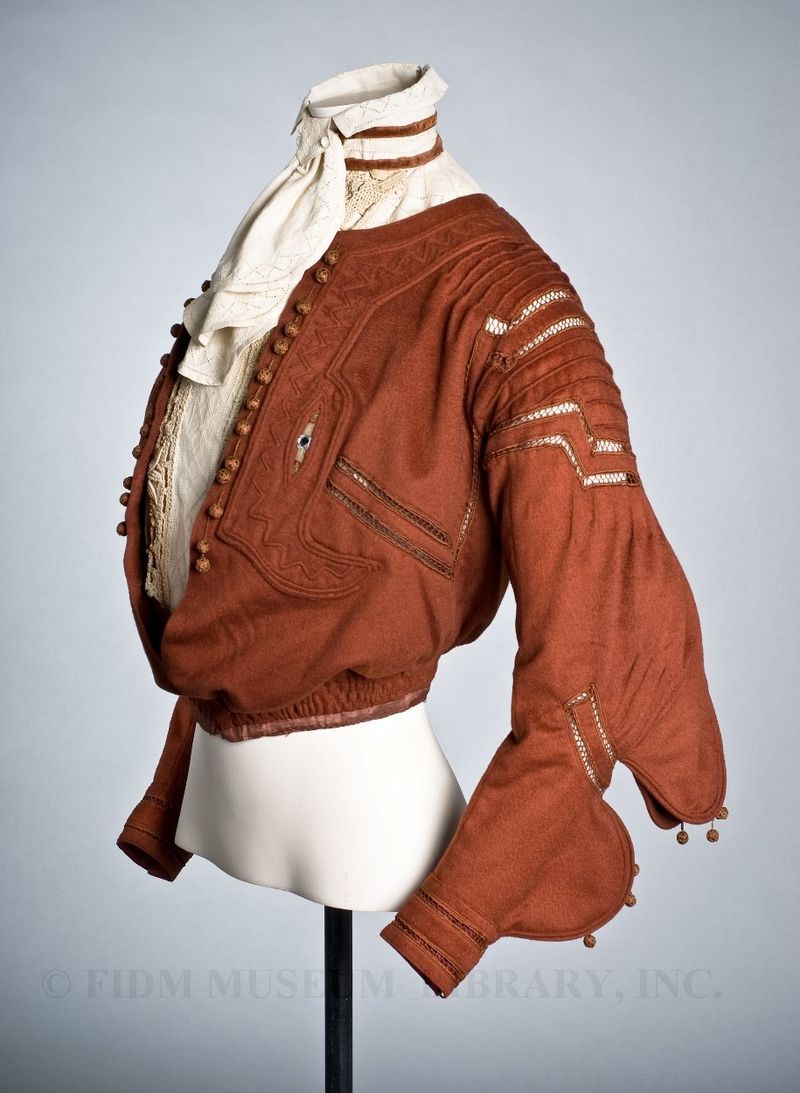Wool and linen bodice, c. 1904
This bodice from our Study Collection is something of a puzzle. Though its silhouette concurs with the mid-1910s, the embellishment is somewhat idiosyncratic, suggesting that the wearer had a very specific sartorial vision. Consisting of an open-front bodice worn over a natural linen dickey, it features the rounded “pouter pigeon” bust popular during the first decade of the twentieth century. If worn with a matched skirt that fitted smoothly over the hips, the wearer would have achieved the fashionable S-bend silhouette. Characterized by a rounded, forward leaning torso with hips pushed back, the S-bend dominated fashion from 1900 to about 1910.
 Day bodice
Day bodice
c. 1904
Gift of the Los Angeles County Museum of Art
S79.429.1A-E
Because of its tall, stock collar we know this is a day bodice; respectable women covered their neck during the day, though evening gowns often revealed an expanse of neck and shoulders, accompanied by a hint of décolletage. The modest collar is accessorized with three detachable ovals of matching linen. Here, we’ve styled them to create a cascading stock collar. According to a period fashion editorial, “ The woman who insists upon the tidy and trim high neck dressing for street wear will find plenty of dainty styles ready for her selection," including collars made from embroidered lawn, linen, net, Irish lace, and crochet.1
The sleeves are intriguing and unusual. Sleeves dating from this period often feature a billowing bishop sleeve confined by a cuff. Instead, these sleeves feature two half-circles bisected by a band of fagoting. Dangling net-covered balls decorate the sleeves and bodice front. Rows of tucks and fagoting embellish and shape the shoulder and upper sleeve. Fagoting, a type of openwork stitch used to create a decorative seam, was just one of many decorative needlework techniques applied to garments during this period. Here, fagoting on the outer bodice is complemented by diamond patterned openwork and crocheted trim on the dickey.
Nestled in the trapunto embroidery decorating each side of the bodice front are small mirrorwork accents. Mirrorwork, or shisha embroidery, consists of small pieces of mirror anchored to fabric with decorative embroidery stitches. The technique probably originated in the region now encompassed by Western India, Pakistan and Afghanistan and may have originated as a way to imitate costly cloth of gold or silver textiles. Specific designs vary depending on the area of origin, often consisting of geometric motifs. In some regions, the small bits of mirror are believed to counteract the evil eye. Here’s hoping that the tiny bit of mirrorwork on this bodice protected the wearer from the evil eye!
Though this bodice was donated without any information on the maker or wearer, the decorative scheme suggests an interest in non-western cultures. Were the unusual decorative details solely the work of an inspired seamstress, or were they influenced by the interests (and travels?) of the wearer? Was this a one-of-a-kind bodice, or are there similar examples out there? We’ll keep looking, but let us know if you see something similar!
1 "Pretty Neckwear for Trim Spring Suits." San Francisco Chronicle. (4 Apr. 1909) 8.